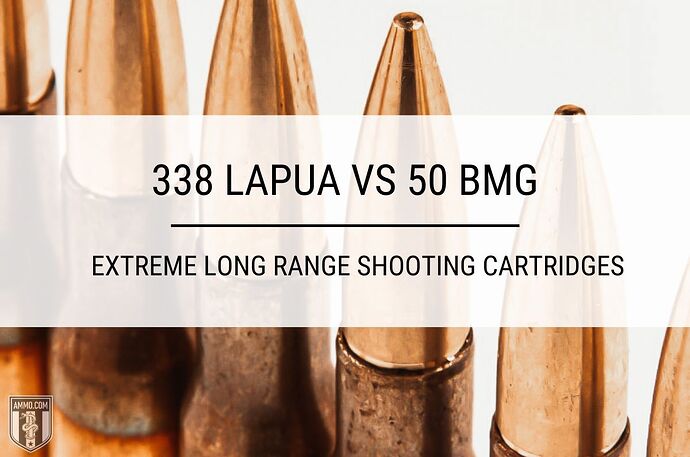These two military rounds take the concept of long-distance shooting to a new level: the 338 Lapua Magnum, and the 50 BMG.
The 50 Browning Machine Gun (aka 50 BMG, .50 Cal, 50 Browning, or 12.7x99mm NATO) is the longest-serving centerfire cartridge in the U.S. military. The 338 Lapua Magnum is a relative newcomer to the long-range shooting scene.
Although initially developed for military use, the 338 Lapua Mag and 50 BMG have found a home with civilian shooters for long-range hunting and F-Class shooting competitions.
Let’s evaluate the 50 BMG vs. 338 Lapua to help you understand the differences between the two rounds and give you a clearer idea of which is better for your long-range shooting needs.
What Is the Difference Between .50 Cal and 338 Lapua Magnum?
The key difference between 50 BMG and 338 Lapua Magnum is this: the 50 BMG is the bigger cartridge, and appropriately fires a larger, heavier bullet with more kinetic energy. Although the 338 Lapua has considerably less case capacity than the 50 BMG, both rounds have similar muzzle velocities.
Cartridge Specs
Perhaps the most obvious difference between these two rounds is their size. The 50 BMG’s case length towers over 338 Lapua Mag’s: 3.910” compared to 2.724”. The disparity only increases in terms of overall length. The 50 BMG measures 5.450”, whereas the 338 Lapua has a maximum overall length of 3.681”.
The 50 BMG fires a considerably larger projectile, with a diameter of 0.510” compared to the 338 Lapua’s 0.338”.
Civilian 50 BMG factory ammo is typically loaded with bullets weighing between 650 and 750 grains, while the 338 Lapua is generally loaded with 200 to 300 grain bullets.
| 338 Lapua | 50 BMG | |
|---|---|---|
| Parent Case | .416 Rigby, .338/.416 | Unique Design |
| Bullet Diameter | 0.338 in | 0.51 in |
| Neck Diameter | 0.372 in | 0.56 in |
| Base Diameter | 0.587 in | 0.804 in |
| Case Length | 2.724 in | 3.91 in |
| Overall Length | 3.681 in | 5.45 in |
| Case Capacity | 114.2 grains | 292.8 grains |
| Max Pressure (SAAMI) | N/A | N/A |
Those massive bullets require a lot of powder to propel them down the barrel. The 338 Lapua’s case capacity is larger than most rifle cartridges at 114.2 grains H2O. Still, that’s not very much compared to the 50 BMG’s 292.8 gains.
Recoil
The 50 BMG’s massive case capacity and projectiles come at a cost: massive recoil. That’s a major reason why many shooters prefer the smaller 338 Lapua.
It is impossible to perform a pure apples-to-apples recoil comparison, as both cartridges are fired in very different firearms. That being said, we can objectively compare the rounds’ free recoil, which is a function of four factors: muzzle velocity (fps), propellant charge weight, bullet weight, and firearm weight.
For 50 BMG, we will consider the Barrett Model 82 semi-automatic sniper rifle weighing a whopping 32.7 pounds. For the 338 Lapua, a McMillan Tac-338 bolt-action rifle weighing 13 pounds.
For ammo, we will compare standard military issue 50 BMG M33 ball 660 grain FMJ (2,910 fps muzzle velocity) and 338 Lapua Mag Lapua 250 grain Lock Base FMJ (2,952 fps).
Given these rounds, the 338 Lapua has free recoil of 36.5 ft-lbs. The 50 BMG, 82.7 ft-lbs. In no uncertain terms, the 50 BMG has more than double the free recoil of 338 Lapua Mag.
To put these massive recoil numbers in perspective, an average 308 Winchester load has around 20 ft-lbs of free recoil.
The amounts of recoil produced by the 338 and the 50 BMG are so excessive that virtually every rifle chambered for either comes with a factory-installed muzzle brake. Without it, most shooters would not be able to fire accurately.
Many expert shooters will tell you that the recoil of these rounds is manageable, although that comes from years of training and acclimatization. Learning how to fire these cartridges accurately takes time, as their recoil can easily cause inexperienced shooters to develop a flinch.
Most shooters understand what they’re getting into when they make the decision to purchase a 50 BMG rifle. If you aren’t already experienced with it, then it would be wise to consider professional training to learn how to handle such a mighty round’s recoil.
Continue reading 338 Lapua Magnum vs. 50 BMG: Extreme Long-Range Cartridges on Ammo.com
